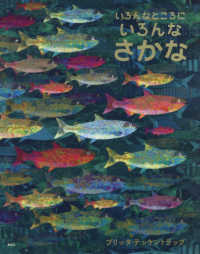Full Description
PCBs have captured the attention of scientists, journalists and the public for three decades, but during most of that time attention was focused on a small number of the 209 possible chlorobiphenyls. Recent work has implicated many of the forgotten and/or unstudied congeners as neuro-endocrine active and potential developmental toxicants. This interest has created a need for information regarding the `non-dioxin-like' PCBs. The ortho Side of PCBs: Occurrence and Disposition integrates historical information, analytical interpretations, and global concepts with recent comprehensive residue reports and public health concerns. This condensed source of extensive information provides detailed comparisons of comprehensive data in a consistent format. The data will improve the accuracy of concepts regarding the occurrence and disposition of the 60-100 (rather than 6-10) most important congeners. Actual PCB burdens are shown to deviate from average steady-state profiles through sporadic exposures to unique mixtures characteristic of individual dietary sources. The task of accurate hazard characterization and risk assessment can be overwhelming, especially when sporadic changes are considered. Models and relationships are suggested to facilitate the efficient categorization and evaluation of the more important congeners.
Contents
1. PCBs: Production and Properties.- 2. The Individual Chlorobiphenyls.- 2.1 GC Retention Times.- 2.2 Other Properties.- 2.3 Congener. Abundance in Former Commercial Mixtures.- 2.4 Congener-Specific Biological Properties.- 3. Interpretation of Analytical Data.- 3.1. Low Resolution GC and Pattern Recognition.- 3.2. Transition from Low Resolution to High Resolution GC.- 3.3. Selection of Analytes.- 4. Atmospheric Transport.- 4.1. Global Compartments.- 4.2 Atmospheric PCB Levels.- 4.3. Dispersion of airborne PCBs.- 4.4. Global Fractionation.- 4.5. Character of Localized Emissions.- 4.6. Accumulation of Airborne PCBs by Vegetation.- 4.7. Other Environmental Pathways for Airborne PCBs.- 4.8 Summary.- 5. The Hydrosphere and Lithosphere.- 5.1. Relative Magnitude of Reservoirs.- 5.2. Movement and Fluxes of PCBs Among Reservoirs.- 5.3. Bioconcentration of PCBs from Water.- 5.4. Bioaccumulation from Multiple Pathway Exposures.- 6. Metabolism and Metabolites.- 6.1 Gone But Not Forgotten.- 6.2 Mass Balance.- 6.3 Oxidative Metabolism.- 6.4 Phase 2 and Phase 3 Metabolism.- 6.5. Dose, Time, Induction and Biotransformation Rates.- 7. Disposition and Toxicokinetics.- 7.1. Toxicokinetics.- 7.2 Very basic toxicokinetic models.- 7.3. Models of oral exposure.- 7.4. PBPK Model of early disposition.- 7.5 Toxicokinetics in Other Classes of Animals.- 7.6. Toxicokinetics and PCB Residue Profiles.- 8. Food Chain Profiles.- 8.1. PCB profiles in fish.- 8.2. PCB profiles in marine mammals.- 8.3. Other profile-altering PCB exposures.- 8.4. Reporting of Human PCB Residues.- 8.5. Characterizing Human PCB Residues.- 8.6. Model of infant exposure to PCBs in human breast milk.- 8.7. Final considerations.- References.- Appendices.- 1. Nomenclature of Polychlorinated Biphenyls.- 2. PCB Congener Weight % inAroclors of 5 Types.- 3. Some Properties of Chlorobiphenyls.- 4. Estimation of PCB Congener Production Ratios.- 5. Comparison of Human Residues Reported by Sample Authors Without Standards Available.- 6. Airborne PCBs.- 7. Percent Congener Composition of PCBs in Various Plants.- 8. Dispersion in Air.- 9. Sediments and Water.- 10. PCB Residues in Fish from the Great Lakes.- 11. "Average" Fish Residue Profiles.- 12. Average Human Milk.- 13. Frequencies of Congener Occurrence in Breast Milk Surveys.- 14. Abbreviations.








